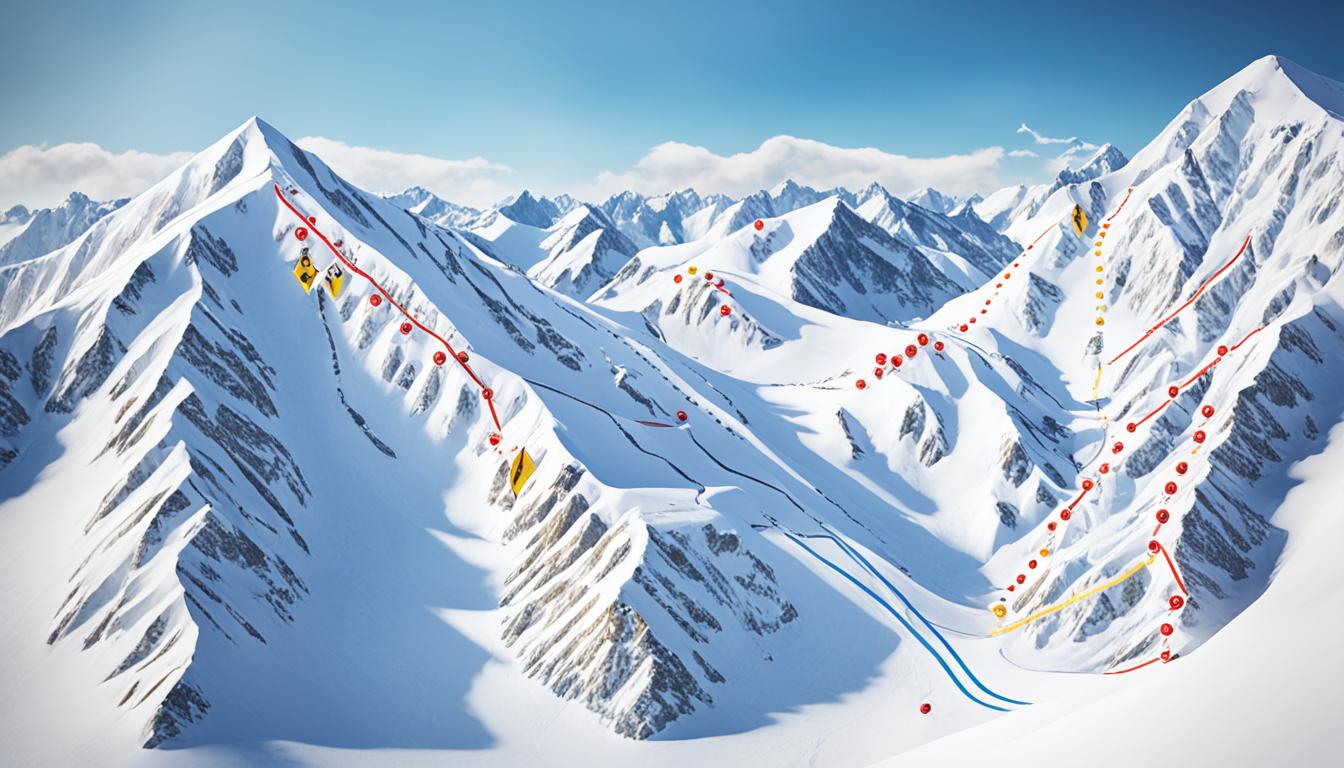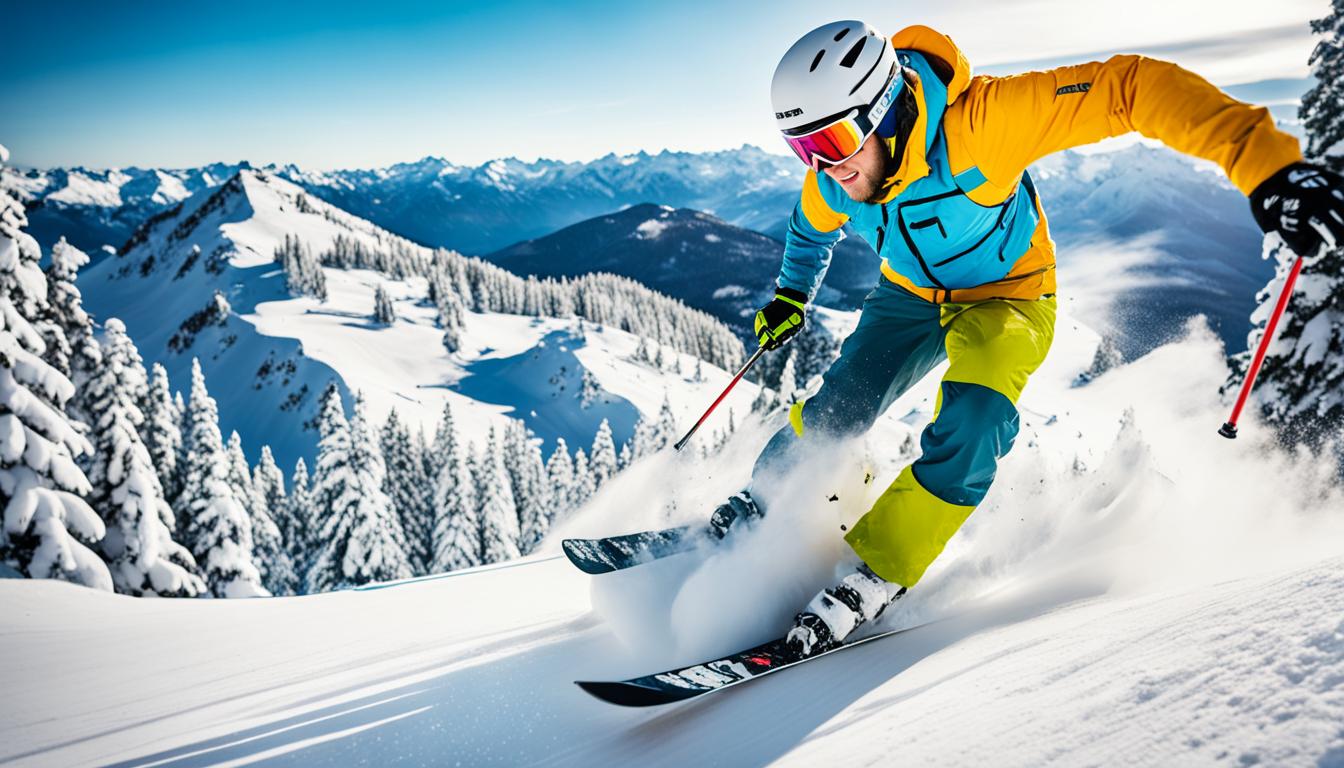As the winter season comes to a close, we find ourselves eagerly anticipating the thrill of spring skiing. The sun shines brightly, warming our faces as we navigate the slushy and sticky slopes. But fear not! We are here to help you prepare for these unique spring skiing conditions so you can make the most of your time on the mountain.
Our expert advice will guide you through essential topics such as maintaining your ski gear, choosing the best destinations, layering for spring skiing, protecting your skin from the sun, waxing techniques, safety precautions, and transitioning smoothly from winter to spring skiing. With our tips and tricks, you’ll be well-equipped to conquer the melting slopes and have an epic end to the season.
Key Takeaways:
- Prepare for spring skiing conditions with the right gear and techniques
- Understand the mechanics of wet friction and how to minimize stickiness
- Choose the appropriate wax for optimal performance on spring slopes
- Maintain speed by carrying essential items for maintenance and touch-ups
- Stay safe by avoiding areas with high levels of environmental pollutants
Understanding Spring Snow Conditions
Spring snow conditions bring their unique set of challenges on the slopes. One key characteristic of spring snow is its stickiness, also known as wet friction. When the snow has a high moisture content, it creates a sticky surface that can slow down your skiing or snowboarding speed. Imagine threads of water, called capillaries, attaching to the base of your skis or snowboard, creating drag.
To prevent the stickiness from affecting your performance and enjoyment, it’s crucial to understand the mechanics of wet friction and how to minimize its effects. By implementing the right techniques and using suitable gear, you can reduce stickiness and ensure smoother gliding on the spring slopes.
To truly grasp the concept of wet friction, let’s take a closer look at how it occurs. When the snow becomes wet and sticky, the tiny capillaries form due to the high moisture content. These capillaries attach themselves to the base of your equipment, creating extra friction as you slide on the surface. This added resistance can noticeably reduce your speed, making it more challenging to navigate the slopes with ease.
Tackling Sticky Spring Snow
To combat the stickiness of spring snow and experience better gliding, here are some effective tactics:
- Choose the right wax: Selecting the appropriate wax for spring conditions is crucial. Opt for a wax that is specifically designed to minimize wet friction. These waxes typically have a high fluorocarbon content, making the base more waterproof and reducing the drag caused by sticking to the snow. Check the packaging or consult with the experts at your local ski shop to find the best wax for sticky spring snow.
- Regular waxing: Wax your skis or snowboard regularly to maintain optimal performance on the slopes. This will help prevent the snow from sticking to the base and ensure smoother gliding. Consider reapplying wax after every few runs or as needed to tackle the stickiness effectively.
- Keep your base clean: Before applying wax, make sure your base is clean and free from dirt or grime. This will allow the wax to adhere properly and create a smooth surface. Use a citrus base cleaner and a paper towel to remove any visible debris before waxing.
- Brushing your base: After applying wax, use a nylon brush to create a cross-hatching pattern on the base. This technique encourages water to flow to the edges, reducing the presence of capillaries and increasing glide efficiency.
By using these techniques, you can significantly minimize the stickiness caused by spring snow. Glide effortlessly, maintain speed, and enjoy an unforgettable spring skiing experience.
Waxing Techniques for Spring Skiing
Waxing your skis or snowboard is crucial for optimizing performance on spring slopes. In spring skiing conditions, it is recommended to use a wax with a high amount of fluorocarbons, as this type of wax makes the base waterproof and reduces friction caused by wet friction.
However, there have been concerns about the environmental impact of fluorocarbons. Some companies have developed environmentally friendly wax options that are just as effective but more sustainable. These include waxes like the UR10 Yellow Bio Racing Wax and the PS10.
It is important to choose the right wax for the spring conditions and apply it correctly to ensure maximum performance and minimize stickiness.
Benefits of Fluorocarbon Wax
Fluorocarbon wax is highly recommended for spring skiing due to its exceptional water-repellent properties. This type of wax creates a hydrophobic barrier on the base of your skis or snowboard, keeping them gliding smoothly through the wet snow. By reducing the friction caused by wet friction, fluorocarbon wax enhances your overall performance and allows for faster speeds on the slopes.
Environmentally Friendly Options
For those concerned about the environmental impact of fluorocarbon wax, there are alternative options available. Environmentally friendly waxes provide a sustainable alternative without compromising performance. The UR10 Yellow Bio Racing Wax and the PS10 are excellent choices that offer comparable glide and waterproofing properties to traditional fluorocarbon waxes. By opting for these environmentally friendly options, you can enjoy a guilt-free spring skiing experience.
Proper Application
To achieve optimal results, it is essential to follow the correct waxing techniques for spring skiing. Here are some steps to help you apply the wax effectively:
- Clean the base of your skis or snowboard using a citrus-based cleaner to remove any dirt or debris. This will ensure better adhesion of the wax.
- Choose the appropriate wax for the temperature and snow conditions. For spring skiing, a warmer temperature wax is recommended.
- Apply the wax evenly to the entire base, starting from the tip and working towards the tail. Use a waxing iron to melt the wax and spread it smoothly.
- Allow the wax to cool and solidify before scraping off the excess wax with a plastic scraper. This will leave a thin, uniform layer on the base.
- Using a waxing brush, gently brush the base in the direction of the ski or snowboard’s running surface. This will help further distribute the wax and improve its effectiveness.
By following these waxing techniques, you can ensure that your skis or snowboard are properly prepared for the challenges of spring skiing.
| Product | Description |
|---|---|
| UR10 Yellow Bio Racing Wax | An environmentally friendly wax option with comparable glide and waterproofing properties to traditional fluorocarbon waxes. |
| PS10 | A sustainable wax option that offers excellent performance on spring slopes while minimizing environmental impact. |
Choose the right wax for your spring skiing adventures and enjoy smooth glides while minimizing the impact on the environment.

Tips for Maintaining Speed on Spring Slopes
Even with the right wax and preparation, there might be instances where you start to stick on spring slopes. To maintain speed and minimize stickiness, it is helpful to carry some essentials with you.
“Carrying the right tools can make a significant difference in your spring skiing experience.”
Dealing with Stickiness
One of the key methods for dealing with stickiness is to clean the base of your skis or snowboard thoroughly. We recommend carrying a small bottle of citrus base cleaner, such as Base Cleaner X, to remove any visible dirt or debris. Before applying wax, use a paper towel to wipe off any excess cleaner.
Using Citrus Base Cleaner
List of essentials to carry for maintaining speed on spring slopes:
- Citrus base cleaner (e.g., Base Cleaner X)
- Paper towel for wiping off excess cleaner
- Warm weather-specific paste wax (e.g., Maxiglide Maxx Waxx) for quick touch-ups
- Nylon brush to create a cross-hatching pattern on the base, directing water to the edges and clearing the base more efficiently
By using the citrus base cleaner, you can remove any stubborn grime that may be causing stickiness and achieve a clean base for optimal performance.
Brushing the Base
Brushing the base is another effective technique for minimizing stickiness. Use a nylon brush to create a cross-hatching pattern on the base, as this helps to direct water to the edges and clear the base more efficiently. This technique enhances glide and reduces the chances of sticking on the snow.
Additional tips for maintaining speed and reducing stickiness:
- Regularly inspect your skis or snowboard for any damages or rough spots on the base and have them repaired professionally if necessary.
- Consider getting a stone grind at a shop for a thorough and professional solution to stubborn stickiness.
- Observe and learn from experienced spring skiers to discover new techniques for improving speed and minimizing stickiness.
Remember, maintaining speed on spring slopes goes beyond the right wax; it’s about having the right tools, techniques, and knowledge to tackle stickiness effectively.
| Essentials for Maintaining Speed on Spring Slopes | Key Benefits |
|---|---|
| Citrus base cleaner | – Removes visible dirt – Improves glide – Reduces stickiness |
| Paper towel | – Wipes off excess cleaner – Ensures a clean base for waxing |
| Warm weather-specific paste wax | – Provides quick touch-ups – Optimizes performance on spring slopes |
| Nylon brush | – Creates a cross-hatching pattern on the base – Directs water to the edges – Clears the base more efficiently |
Staying Safe on Spring Slopes
When hitting the slopes during spring skiing, it’s important to consider not only the snow conditions but also the environmental factors that can impact your experience. Environmental pollutants such as tree pollen or sap, volcanic ash, exhaust fumes, and salt from snowmaking operations can affect the quality of the snow and pose risks to skiers and snowboarders.
To stay safe on spring slopes, we recommend taking the following precautions:
Avoiding Dirty Snow
Dirty or discolored snow can indicate the presence of pollutants, so it’s best to steer clear of such areas. This includes avoiding patches of snow that appear brown, gray, or have visible debris. By choosing clean, pristine snow, you can minimize the potential risks associated with environmental pollutants.
Staying Informed about Snow Conditions
Keeping yourself updated about snow conditions is crucial for making informed decisions on the slopes. Check local snow reports, avalanche bulletins, and weather forecasts before heading out. These resources will provide valuable information about the quality of the snow, potential hazards, and any advisories or warnings that may be in effect.
Taking Note of Avalanche Risk
Spring skiing can bring increased avalanche risk due to changing temperatures and snowpack stability. Keep an eye on avalanche bulletins to stay informed about the current risk level and any specific areas to avoid. If you’re planning backcountry skiing or snowboarding, ensure you have the necessary training, equipment, and knowledge to navigate avalanche terrain safely.
Protecting Yourself from Tree Pollen and Sap
If you’re allergic to tree pollen or sap, it’s important to take precautions to minimize your exposure. Consider wearing a face mask or goggles to prevent inhalation of pollen particles. Additionally, avoid skiing or snowboarding near trees that are actively releasing pollen or sap. Tree-free slopes may provide a safer and more enjoyable experience.
By being mindful of environmental pollutants, staying informed about snow conditions, and taking necessary precautions, you can have a safe and enjoyable spring skiing adventure. Remember, your safety should always be a top priority on the slopes.
Transitioning from Winter to Spring Skiing
Transitioning from winter to spring skiing requires adjustments in clothing, gear, and skincare. As the temperatures fluctuate throughout the day, layering becomes essential to adapt to changing conditions. Here are some tips to help you make a smooth transition and have a comfortable and enjoyable spring skiing experience.
1. Layering for Spring Skiing
Layering is key when skiing in spring conditions. Start with lightweight and moisture-wicking base layers that will keep you dry and comfortable. Look for materials such as merino wool or synthetic fabrics that offer breathability and moisture management.
Next, add a breathable mid-layer that provides insulation without overheating. Fleece or softshell jackets are great options to regulate your body temperature in varying weather conditions.
Finally, top it off with a waterproof outer layer to protect yourself from any wet snow or spring showers. Choose a jacket and pants with a high waterproof rating and sealed seams for maximum protection.
Remember to pack extra layers in your backpack, as conditions can change rapidly during spring skiing. This way, you can add or remove layers as needed throughout the day.
2. Sunscreen for Skiing
Spring skiing often means bright sunshine and higher altitudes, which can lead to increased sun exposure. Protect your skin from harmful UV rays by applying sunscreen before hitting the slopes.
Choose a broad-spectrum sunscreen with a high SPF and apply it generously to all exposed areas, including your face, neck, and hands. Don’t forget about your ears and any other areas that might be exposed to the sun. Reapply every two hours or more frequently if you’re sweating or spending extended periods of time outside.

3. Adjusting Equipment
Spring skiing conditions, with their softer snow, require adjustments to your ski or snowboard equipment. Start by checking your bindings and ensuring they are properly adjusted for your weight and skiing style. This will help provide the optimal balance between control and release.
Flex your boots to a softer setting to allow for better maneuverability in the softer snow. This will help absorb any uneven terrain and bumps you may encounter.
If you’re unsure about adjusting your equipment, consult a professional technician at a ski shop for assistance. They can help you make the necessary adjustments to match the specific spring skiing conditions you’ll be facing.
By layering appropriately, using sunscreen, and adjusting your equipment, you can comfortably transition from winter to spring skiing. Embrace the changing conditions and enjoy the beauty of the mountains in this transitional season.
Conclusion
Preparing for spring skiing conditions is essential to fully enjoy the unique experience that this transitional period on the slopes offers. By following the expert advice in this comprehensive spring skiing guide, you’ll be well-equipped to tackle the challenges and make the most of your time on the melting slopes.
Understanding the mechanics of wet friction and choosing the right wax are crucial for maintaining speed and minimizing stickiness on the spring snow. With the appropriate gear, such as fluorocarbon waxes or environmentally friendly alternatives, you can optimize your performance while minimizing the impact on the environment.
It’s also important to stay updated on snow conditions and be aware of environmental factors that can affect your skiing experience. By avoiding “dirty” snow and areas with high levels of pollutants, you can ski in a safer and cleaner environment.
Whether you’re adjusting your clothing layers, applying sunscreen to protect your skin, or making adjustments to your equipment, preparing for spring skiing conditions is all about adapting to the changing weather and snow conditions. With the tips and techniques provided in this guide, you’ll be ready to embark on an unforgettable spring skiing adventure, conquering the melting slopes with confidence and excitement.
FAQ
What are some tips for preparing for spring skiing conditions?
To prepare for spring skiing conditions, make sure to wax your skis or snowboard with a fluorocarbon wax to reduce stickiness caused by wet friction. Adjust your clothing and gear for the changing temperatures by layering with lightweight, moisture-wicking base layers and a waterproof outer layer. Don’t forget to apply sunscreen to protect your skin from the sun at higher altitudes.
How can I prevent stickiness on spring slopes?
You can prevent stickiness on spring slopes by using the right wax and techniques. Choose a wax with a high amount of fluorocarbons to make the base of your skis or snowboard waterproof. Additionally, carry essential items for maintenance, such as citrus base cleaner and warm weather-specific paste wax, for quick touch-ups.
What should I consider when staying safe on spring slopes?
When staying safe on spring slopes, it is important to avoid snow that looks “dirty” as it may contain environmental pollutants. Stay updated on snow conditions, read avalanche bulletins, and observe weather forecasts to make informed decisions and mitigate risks.
How can I transition from winter to spring skiing?
Transitioning from winter to spring skiing requires adjustments in clothing, gear, and skincare. Layering becomes essential as temperatures fluctuate. Adjust your binding settings and flex of your boots to accommodate the softer snow. Don’t forget to apply sunscreen to protect your skin from the strong sun at higher altitudes.
What are some destinations known for the best spring skiing?
Some destinations known for the best spring skiing include resorts in the Rocky Mountains, such as Aspen, Vail, and Park City. Other popular options include Mammoth Mountain in California and Whistler Blackcomb in British Columbia.




